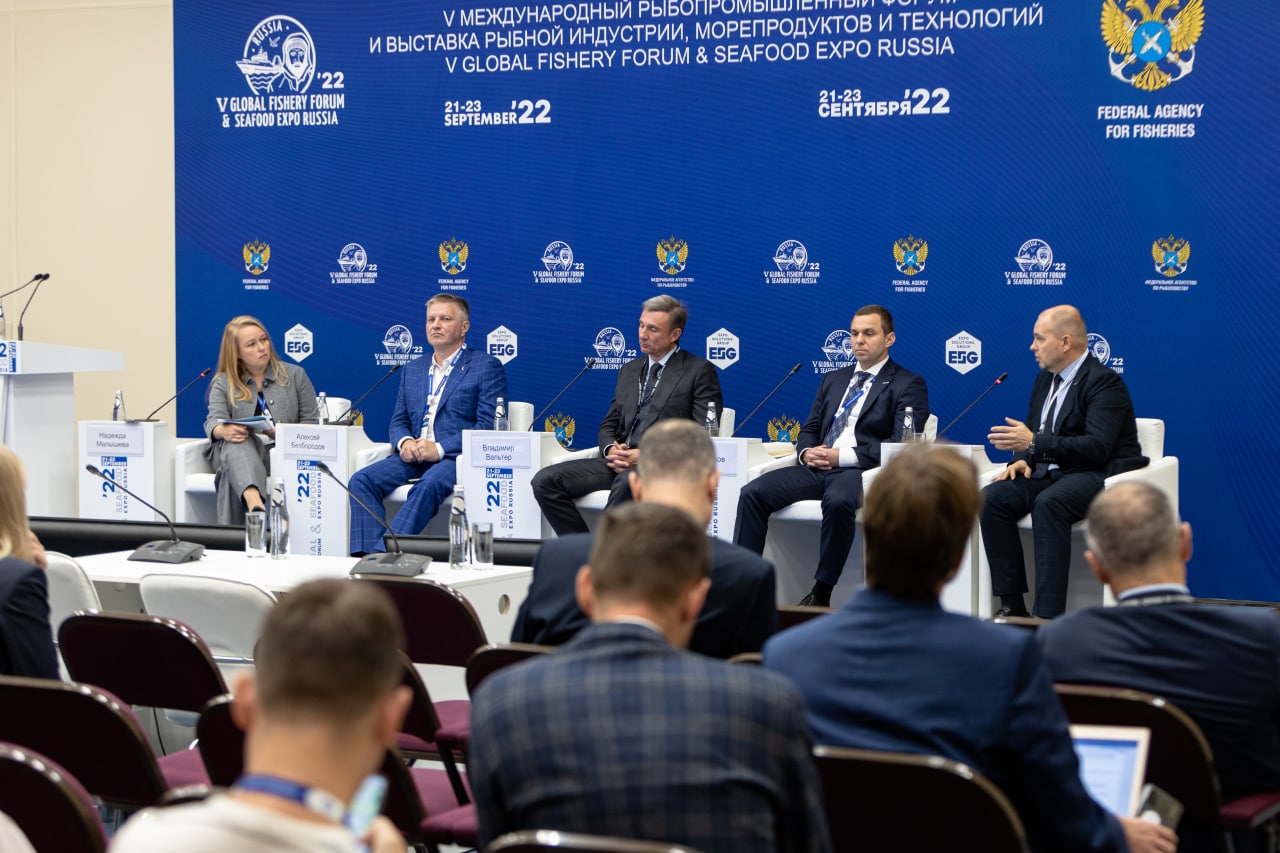October, 22-24, 2025, Saint Petersburg

The conference ‘Practical Issues Facing Fishing Ports: Private Investment and New Logistics’ was held on the second day of the V Global Fishery Forum and Seafood Expo.
The discussion was organized by the PortNews media group and the Expo Solutions Group. The session was moderated by PortNews Development Director Nadezhda Malysheva. Major companies in the fish transhipment market, industry experts, and transport workers presented reports on the industry’s achievements and the problems with its development.
The forum opened with a speech by Seroglazka Terminal (part of the Norebo Group) CEO Vladimir Valter, who outlined the main problems that specialized fishing ports and terminals currently face. The chief problem is the lack of cold-storage facilities at terminals that receive and store fish products.
The Seroglazka Terminal is one of the few examples of how private business can successfully implement projects to modernize port infrastructure. The construction of the building is proceeding as planned. At present, the terminal has annual cargo turnover of 300,000 tonnes.
The second key problem Valter addressed is the lack of new mooring walls and the depths that large vessels need to dock. The problem is particularly relevant for the development of the Northern Sea Route, where the ports and infrastructure need to be upgraded right away, he said.
“The NSR is a good alternative route, but it is crucial to develop and prepare the Murmansk fish terminal and Murmansk berths. What I’m saying is that the terminals in the Far East are more prepared than in the North-West,” Valter said.
Anton Ryzhov, director of the forwarding department of Vladivostok Fish Terminal, who has been in charge of multimodal container cargo transportation since 2022, spoke about the project to create an uninterrupted cold chain at all stages of the transportation of goods and fish products in particular.
Over the past two years, he said the Vladivostok Fish Terminal has carried out extensive work to renovate and expand its infrastructure and storage facilities. In addition to building a new refrigerator, repairs were made to Refrigerator #2 with capacity of 15,000 tonnes. Recently, the port launched a modern container terminal and in 2023 it plans to build a universal complex in the Moscow Region, which includes a facility that can store 10,000 tonnes of products and a fish processing plant. Thus, transport routes in the country’s eastern and western regions will be united in a single chain.
Asked about problems with railway transportation, Ryzhov noted that as cargo has pivoted from west to east, there have been disruptions in both the dispatch of cargo and the transfer of empty containers, especially from pre-port stations. To alleviate the load, the Vladivostok Fish Terminal launched a terminal in Ussuriysk, but this did not solve the problem entirely.
Alexey Bezborodov, CEO of the research agency InfraNews, noted in his speech that container fleet operators are rapidly crowding out refrigerated fleet operators on the maritime refrigerated transportation market. In 2020, container ships had a 74% share of the global refrigerated transportation market, but Drewry forecasts this share will exceed 90% by 2025. Meanwhile, the global fleet of refrigerated containers increased by about 200,000 feu to 1.3 million TEU in 2021.
From April 2020 to March 2021, Drewry estimates that the global fish and seafood transportation market amounted to around 28 million tonnes, of which 60% is transported by sea.
“The transportation of containers by rail in Russia features pronounced seasonal fluctuations. Demand peaks in the second half of the year, which is largely due to the seasonality of the fishing industry,” Bezborodov said.
Asked about the problems of empty containers in spring 2022, Bezborodov noted that this shortage was related to organizational issues. Experts say the total volume of refrigerated containers in operation is sufficient to meet demand.
Sergey Smirnov, director of the Sozvezdie Association of Oil and Gas Suppliers, spoke about the current state of the Port of Arkhangelsk.
In 2021, the port handled more than 5 million tonnes of cargo, a quarter of which were exported. Transhipments increased by around 9% compared with the previous year. In early 2022, port workers predicted an even greater increase in transhipment volumes.
The port’s main problems are also related to infrastructure, such as the poor condition of roads and the heavy load on the railway network and junctions.
The regional government is aware of the problems and has actively repaired the roads in recent years. Port workers themselves are building park and ride facilities.
Commenting on the advantages of the Arkhangelsk transport hub, Smirnov pointed out its ship repair facilities. The region has floating and dry docks and all the necessary platforms. It also has a comprehensive service for fishing companies, which not only includes loading and unloading operations, but also bunkering, supply, and after-sales service.
Wrapping up the session, the speakers expressed hope that the funds invested in the modernization of infrastructure will result in an increase in the fish catch and improve logistics.
The ban on the import of European fish products has significantly boosted investment in Russia’s own fish catch and production. This, in turn, has led to growth in the domestic transportation of fish, mainly by rail from the Primorye region to the centre of consumption in the west of the country.
The pivot of foreign trade from the west to the east and south has made Far Eastern ports more important and resulted in the active development of infrastructure and capacity, including investment in the processing and storage of fish and seafood.



